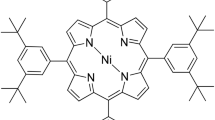Abstract
In this present research work, we presented a new Bottom Gate P-Type Organic Field Effect Transistor (OFET) humidity sensor and its applicability towards humidity has been experimentally demonstrated. P-type organic semiconductor polyaniline (PANI) has been used in a variety of applications, including logic circuit components, electromagnetic shielding, chemical sensing, and anticorrosion. Humidity sensor can be used to monitor relative humidity (RH) in various environments. We only focus on the fabrication of conducting polymer OFETs with top contact to measure humidity and verify I-V properties. The current saturation (ISat) of p-type OFETs was 0.8 μA, while the threshold voltage VTh was 2.2 V. The results of FESEM have been perform to confirm that deposited thin film grown on the substrate is purely uniform. The Proposed sensor shows that organic gate dielectrics are a low-cost alternative to inorganic gate dielectrics with good electrical performance. The proposed OFET-based sensors have a number of benefits, such as high sensitivity, low cost, quick response, and physical flexibility.
Similar content being viewed by others
Data Availability
Data is available and material also available to support the result.
References
Roy S, Dey A, Biswas B, Sarkar SK (2018) Investigation of Pt and Pd modified WO3 and ZnO based thin film sensors for ethanol sensing. JMEP, Springer 27(6):2635–2642
Dey A, Kantha B, Sarkar SK (2016) Sol–gel grown Pd modified WO3 thin film based methanol sensor and the effect of annealing temperatures. Microsyst Technol. https://doi.org/10.1007/s00542-016-2841
Dey A, Kantha B, Sarkar SK (2017) Study the effects of annealing temperatures on sol-gel derived TiO2 sensing element”, International Conference on Computational Science and Engineering, Kolkata, India. October 4–6, 2016. Published as a book chapter in Computational Science and Engineering, Taylor & Francis Group, pp-247-250, ISBN: 978-1-315-37502-1
Gupta N, Sharma S, Mir IA, Kumar D (2006) Advances in sensors based on conducting polymers. J Sci Industr Res 65:549–557
Elkington D, Cooling N, Belcher W, Dastoor PC, Zhou X (2014) Organic thin-film transistor (OTFT)-based sensors. Electronics 3:234–254
Pure JS (2002) Polyaniline.;preparation of a conducting polymer, (IUPAC). Pure Appl Chem 74(5):857–867
Chen D, Lei S, Chen Y (2011) A single polyaniline nanofiber field effect transistor and its gas sensing mechanisms. Sensors (Basel) 11(7):6509–6513
Nohria R, Khillan RK, Su Y, Dikshit R, Lvov Y, Varaharmyan K (2006) Humidity sensor based on ultrathin polyaniline film deposited using layer-by-layer nano-assembly. Sensors Actuators B 114:218–222
Adhikari B, Majumdar S (2004) Polymers in sensor applications. Prog Polyrn Sci 29:699–766
Khodagholy D, Rivnay J, Sessolo M, Gurfinkel M, Jimison LH, Stavrinidou E, Malliaras GG, Herve T, Sanaur S, Leleux P, Owens RM (2013) High transconductance organic electrochemical transistors, nature. Communications 4:2–6
Amer K, Ebrahim S, Feteha M, Soliman M, El-Shaer A (2017) Organic field effect transistor based on polyaniline - Dodecylbenzene Sulphonic acid for humidity sensor. Natl Radio Sci Conf
Park SH et al (2007) Lattice relaxation mechanism of ZnO thin films grownonc-Al2O3substrates by plasma-assisted molecular-beam epitaxy. Appl Phys Lett 91(23):231904–231907
Majewski J (2016) Polymer-based sensors for measurement of low humidity in air and industrial gases, PRZEGLĄD ELEKTROTECHNICZNY, ISSN 0033-2097
Rathi K, Pal K (2017) Impact of doping on GO: fast response−recovery humidity sensor. ACS Omega 2:842–851
Choi S-J, Yu H, Jang J-S, Kim M-H, Kim S-J, Jeong HS, Kim I-D (2018) Nitrogen-doped single graphene Fiber with platinum water dissociation catalyst for wearable humidity sensor. Small 14:1703934
Sun SA, Huang L, Li Y (2009) Study on humidity sensing property based on TiO2 porous film and polystyrene sulfonic sodium. Sens Actuator B-Chem 139:543–547
Murtaza I, Karimov KhS, Ahmad Z, Qazi I, Mahroof-Tahir M, Khan TA, Amin T (2010) Humidity sensitive organic field effect transistor. J Semiconduct 31(5)
Borini S, White R, Wei D, Astley M, Haque S, Spigone E, Harris N, Kivioja J, Ryhänen T (2013) Ultrafast graphene oxide humidity sensors. ACS Nano 7:11166–11173
M. Hussain, S. Hasnain , N. A. Khan, S. Bano , F. Zuhra, M. Ali, ,M. Khan , N. Abbas ,and A. Ali , Design and fabrication of a fast response resistive-type humidity sensor using Polypyrrole (Ppy) polymer thin film structures, Polymers,2021
Acknowledgements
We thankfully acknowledge the financial support for this research work obtained from CSIR, Govt. of India (Ack.No.-143170/2 K15/1). Authors would like to thank Prof. Kalyan Kumar Chattopadhyay (Director, School of Material Science and Nanotechnology, Jadavpur University, India) for FESEM facility.
Author information
Authors and Affiliations
Contributions
Professor Subir kumar Sarkar analyzed data after taking humidity sensor data and guided us to complete the whole work. Anup Das helps in oxidation process. Mandira Biswas has a major contribution in writing the manuscript and after getting the data to plot the figure. All authors read and approved the final manuscript.
Corresponding authors
Ethics declarations
Ethics Approval and Consent to Participate
Not applicable.
Consent for Publication
Not applicable.
Competing Interests
The authors declare that they have no competing interests.
Additional information
Publisher’s Note
Springer Nature remains neutral with regard to jurisdictional claims in published maps and institutional affiliations.
Rights and permissions
About this article
Cite this article
Biswas, M., Dey, A. & Sarkar, S.K. Polyaniline Based Field Effect Transistor for Humidity Sensor. Silicon 14, 8919–8925 (2022). https://doi.org/10.1007/s12633-021-01594-3
Received:
Accepted:
Published:
Issue Date:
DOI: https://doi.org/10.1007/s12633-021-01594-3




